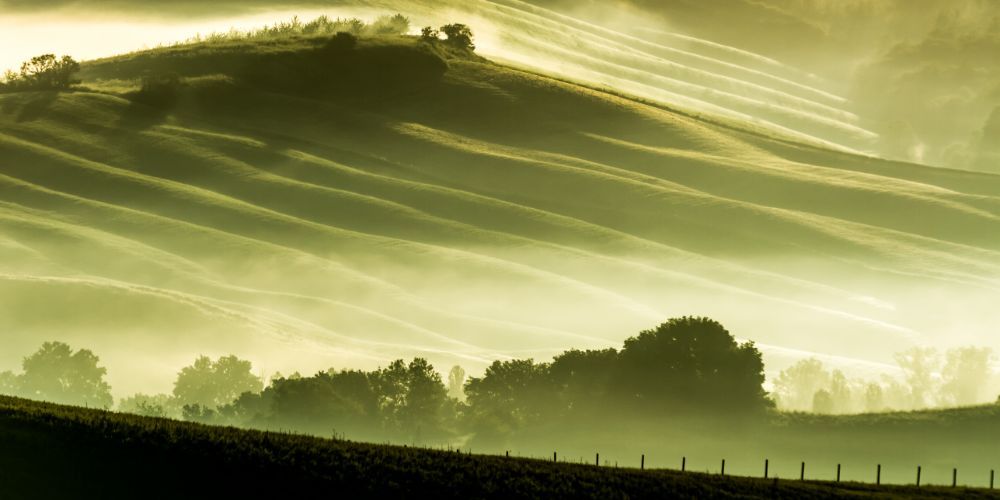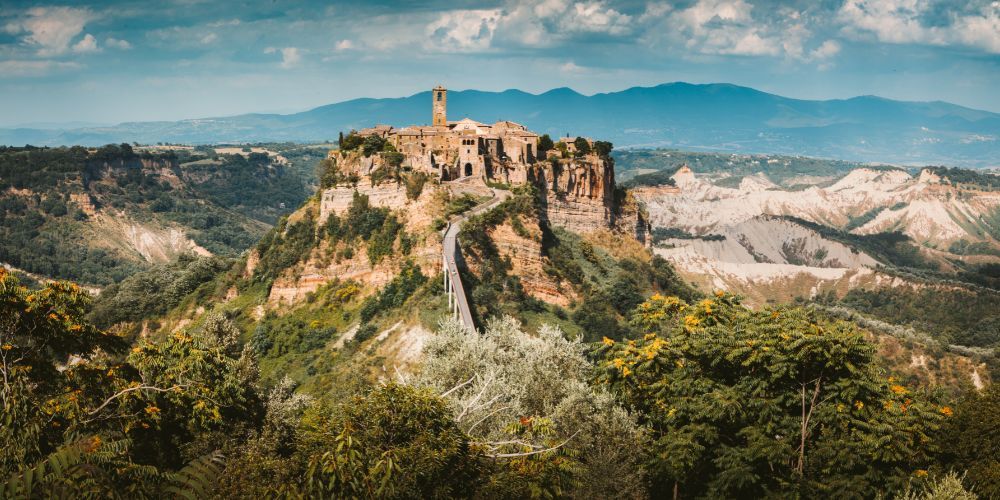There are many reasons why they became abandoned towns: it may have been for human needs, or natural causes, or even paranormal phenomena.
Today, the ghost towns in Italy tell stories to which few people can listen. Once they were home and refuge of someone, today a heap of stones full of evocative and eternal charm. And why not, top destinations to visit this autumn - perhaps feeling a few chills down your spine.
And what better way to celebrate Halloween, or the Day of the Dead, than undertaking a tour through ghost towns in Italy for rediscovering their past and legends, and maybe even meet some phantoms?!
We've chosen for you 18 ghost towns in Italy to enjoy a thrilling journey through unique and mysterious locations, nice destinations to visit as alternative stops in autumn.

18. Ghost towns in italy: Umbriano (Terni, Umbria)

Umbriano is a castle currently abandoned in the municipality of Ferentillo (Terni). Built on the Northside of Monte Sant'Angelo in 890 after the Saracen invasions in Umbria. The fort was in a dominant location and hard to attack.
It was in an area without link routes with the Valnerina and economic attractions. During the second postwar, there was a progressive depopulation since 1950, that turned it into one of the most euthentic ghost towns in Italy.
Include an exciting and culturally rich experience in your trip across the south of the region, by visiting the underground town of Narni with the ticket offered by Visit Italy.
Book your ticket to visit Underground Narni17. Tower of Sperone (L’Aquila, Abruzzo)

Sperone is a castle hamlet and is today in the municipality of Gioia Dei Marsi. Centuries ago, an ancient Roman garrison used to raise who supervised Passo Sparnasio, not far away.
The hamlet took the name from two castles that made it: Sparnasio and Asino, from this Speron D'Asino. It was at an altitude of about 1250 meters overlooking the valley; indeed, it was actually for this location to make it a strategic place.
A strategy lost value when the area depopulated and lost its sentinel role, relegating it simply to the position of Balcony on the Marsica, thanks to its landscapes.
Are you looking for other charming mountain castles in the heart of Abruzzo? Then check out Rocca Calascio!
16. Castiglione (Rome, Lazio)

Among the gost towns in Italy to visit this autumn there's Castiglione, in the area of Rome, precisely on Monti Lucratini. Its name takes origin from its old castle, which seems to come from the earlier Roman settlement, where probably a noble used to live and decided to build his house on this hill.
Thanks to the building of this new castle and the transfer of ownership of this last one, Castiglione became a proper town. Unfortunately, the news about Castiglione stopped in the 15th century, when people probably abandoned it for reasons still unknown.
Who knows if meanwhile Castiglione has become a ghostly village...like the ones you can discover in our guide to haunted places in Italy.
15. Stazzano Vecchio (Rome, Lazio)

Stazzano Vecchio is a hamlet close to Rome, of which we still don't know enough and of which seems that everyone forgets. Lost and forgotten into the Sabina Romana, the ghost town of Stazzano Vecchio is a small lonely gem.
During the centuries, the men made an inhabited hub perfectly integrated with surrounding nature which, in the years, took over.
The few adventurers who decide to visit this village, one of the enchanting ghost towns in Italy, find a place of other times, surrounded by a suggestive and seductive scenario, which preserves all the past charm quite unknown yet.
14. Col di Favilla (Lucca, Tuscany)

Col di Favilla was a tiny village born as an alpine pasture of the town of Levigliani, which started to be a permanent settlement in 1880. The inhabitants used to devote themselves to sheep farming, agriculture, drilling of chestnut tannin, bottoming of the chairs and metalworking in the forges of the area.
The village had significant damage after World War II and the people started to abandon it until it became a ghost town.
Over the years, the descents of the ancient inhabitants provided to restore the church of the town and every year, on July 26th, on the occasion of St. Anna's feast, to whom the church was dedicated, and revive the tiny hamlet.
Take the unique chance to explore the picturesque corners of Lucca in a weekend, or visit the near and enchanting Pisa with its iconic Piazza dei Miracoli.
13. Scoppio (Terni, Umbria)

Scoppio di Acquasparta is a small ghost town in Italy where currently live only ten people. The name comes from the Latin word Scopulus which identifies the dominant location where it is.
Until 1750, in the town lived only 25 families. Around 1950, the people started to abandon it forever because of a series of earthquakes.
The tiny hamlet, isolated on a rocky spur, is a destination for many hikers who take the Monti Martani's paths.
Among its fascinating monuments is the Romanic church of St. Angelo, built in the XV century. It is still possible to admire some parts of the 14th-century wall that survived the earthquakes.
Scoppio has currently had requalification that has back into the mainstream. For example, it was part of the movie set upon Pope Francis, directed by Wim Wenders, and some video clips of the U2 band.
12. Borzellino (Palermo, Sicily)

Those who love ghost towns in Italy should definitely include a visit to Borzellino, a ghost hamlet in Monreale, among the things to do in Palermo. It was a fascist hamlet, but differently from the other rural villages of this period, Borzellino was relatively close to a residential area, San Cipriello.
Here you can even find an evocative ghost railway: Palermo-Camporeale.
It must be one of the villages for the project of requalification of South Italy through agriculture. But, unfortunately, they never completed it, so it became one of the many ghost towns.
The works started in the 40s, and they blocked them after the allied landings. Borzellino must be a classy hamlet with all the amenities and comforts because it was the baseline village of the area.
The works finished in 1955, but the building of these villages was a little optimistic, considering the earlier bad results. Like the others, Borzellino was poorly projected and had imperfections that made it unlivable.
Today the hamlet is a living paradox. Thanks to the nearby motorway, in the morning it seems almost a lively town, while at night, you can feel the typical ghost town's atmosphere: squeaky doors and windows, hangers and gates that slap with the wind...It's scary!
Add to your itinerary a stop in Monreale, maybe on a nice weekend, and visit the extraordinary masterpieces rich in art and history of its famous Cathedral with the ticket offered by Visit Italy.
Book your ticket to visit Santa Maria Nuova in Monreale11. Toiano (Pisa, Tuscany)

Toiano is a village in the municipality of Palaia, in the area of Pisa. It took origin in the early Middle Ages and its structure is that of a castle indeed with an access to the hamlet through a bridge, probably a drawbridge in the past.
The town is sadly known for the murder of a 23-years-old girl, Elvira Orlandini, nicknamed the beautiful Elvira. They founded the girl slaughtered in the woods, and her killing was a media event in 1947.
After this horrible event the people left the town, turning into a real spooky location to discover by traveling to Italy, because they believed that Elvira's ghost haunted and tormented the village.
Haunted village or not, a journey to discover the beauty of Tuscany certainly cannot lack a visit to the famous Leaning Tower of Pisa, in the heart of the provincial main town.
10. Roscigno (Salerno, Campania)

Part of Campania's UNESCO heritage, Roscigno Vecchia is a hamlet in the heart of Cilento National Park. Because of the continuous rockslides and landslides, the inhabitants abandoned it.
A sad epilogue for a village immersed in uncontaminated nature, today become a ghost town - or almost.
The town is not entirely uninhabited, though: because a man still lives here, without any intent to give up his habits, and he is a perfect Virgil for the tourists.
Since 1997, the ghost town of Roscigno with the Park has been on the UNESCO World Heritage List.
9. Celleno (Viterbo, Lazio)

The ghost town of Celleno, in the area of Viterbo, is a rocky village on a tufa rock, where now there are only ruins. It had to face plague and landslides during the years, even a devastating earthquake in 1931.
Right because of the serious instability of the ground on which the town stands, and the high risk of new intense natural phenomena, ancient Celleno was abandoned by its citizens in 1951. Today, it is considered as a proper ghost town.
The absence of manutention saved only the most architectural delicate part of the town, around the square Piazza del Comune. The FAI (Fondo Ambiente Italiano - Italian Environment Fund) has selected the village among its hamlets list and during their open days they organize guided tours.
Lastly, Cellano was the movie set for the Netflix TV series "Luna Nera - Black Moon", dedicated to the XVII-century witch haunting.
Heading to enchanting Viterbo, you could even venture into the enigmatic underground labyrinth of ancient origins, a true hidden town rich in allure and secrets.
8. Osiglia (Savona, Liguria)

Among the ghost towns in Italy, the village of Osiglia is very peculiar. It is in the Savona hinterland of Alta Val Bormida, and more to be a ghost village is, first of all, a submerged town.
Indeed, it is possible to see the village for only a few days every 10-15 years, when it flows out from the same name lake, drained for maintenance to the overrun and dam.
The old hamlet has medieval origins. Indeed, it develops around a castle. Some houses were built in the valley and those builduings, which made the most of the town, were abandoned in 1938 after the dam's construction.
7. Bussana Vecchia (Sanremo, Liguria)

Have you ever thought about visiting Sanremo like a local? Then don't miss the gems in its surroundings, including Bussana Vecchia, only 8 km away and an authentic open-air museum.
In 1887 a strong earthquake seriously affected the town and during which many inhabitants lost the life. The survivors lived in makeshift housing for the next seven years until they ultimately left the town.
After abandonment's years, at the end of the 50s, Italian and foreign artists have restarted living there because attracted by the location and also by other ghost towns in Italy. From the ruins has raised labs and ateliers, exhibitions and vernissages, new ideas to rebirth arrived from the abandonment.
That is why today, the hamlet has become the village of artists. More and more people, fascinated by the town, decided to visit or even return to live in Bussana Vecchia!
6. Balestrino (Savona, Liguria)

Let's stay among Liguria's Villages to talk about the ghost town of Balestrino, on a rocky outcrop a few kilometres from the sea near Loano, in the province of Savona.
Walking through its streets, one has the feeling of entering a post-apocalyptic scenario, where life has suddenly come to a halt. This 'stop' remained marked in its church clock stopped at the time of the earthquake in 1950.
After several landslides and landslips, the village was abandoned completely in 1963 to give way to a new hamlet downstream.
As with other abandoned villages, Balestrino served as a film set for the Hollywood film "Inkheart", directed by Iain Softley, in which Balestrino represents Capricorn Village.
5. Calcata (Viterbo, Lazio)

If you're planning a daytrip from Rome, less than 8 km away in the province of Viterbo, lies the village of artists of Calcata. Perched on a tuff mountain, Calcata was deemed uninhabitable in 1935, remaining deserted for about 30 years.
The village came back to life between the 60s and 70s when once again considered safe. A group of roman hippies went to live there. They, tired and fleeing from the frenzy and capitalism of the capital, saw in the village a place to rebuild society.
Artists from all over the world also came here and decided to open their workshops here. It is why Calcata is also known as the town of artists and hippies.
But Calcata is also known as the town of witches because a legend said that when the wind blows through the village's narrow streets, it is possible to hear the singing of witches. Furthermore, its shape has always been the setting for numerous dreamlike and magical tales.
Today there are about 70 residents in the village. Still, most of the population has four legs: they are the cats of Calcata, many friendly furry friends who have been super-photographed!
4. Civita di Bagnoregio (Viterbo, Lazio)

Remaining in the area and not far from Calcata we find the much better-known town of Civita di Bagnoregio, known as La Città che Muore (The Town that Dies), a nickname given to it by the writer Bonaventura Tecchi.
This small village stands on a spur of tufa rock. Subject to erosion processes that have undermined it over time, it looks like a mysterious fortress to explore.
You can only reach it on foot via a bridge about 1 km long that connects it to Bagnoregio. The bridge offers a breathtakingly beautiful landscape.
Once in the village time seems to have become rarefied. Because of its unique appearance inevitably hosted numerous film sets, including Sironi's 'Pinocchio'. Civita has recently received the nomination for UNESCO World Heritage Site.
Let yourself be captivated by its breathtaking landscape and picturesque architecture, and admire its natural and artistic treasures with the ticket by Visit Italy.
Book your ticket to visit Civita di Bagnoregio by bus from Rome3. Apice Vecchia (Benevento, Campania)

Straddling the provinces of Benevento and Avellino is Apice Vecchia, a town that has 'tasted' the force of nature at its worst. On 21 August 1972, it was hit by an earthquake measuring six on the Richter scale, during which 17 people died.
Following this event, the municipality decided to evacuate the country permanently, leaving it deserted forever! Indeed, a new earthquake followed in 1980, which dealt the final blow.
It is one of the most evocative ghost towns in Italy. Its rather good condition leaves a feeling of endless standby so strong that it has earned the nickname of Pompeii of the 20th century.
However, someone in the village has never abandoned it: the barber Tommaso has always continued to work in the old town.
2. Craco (Matera, Basilicata)

Here is one of Italy's most famous ghost towns! We're speaking of Craco, a picturesque abandoned village not far from the City of Stone in the heart of Basilicata.
Until the 1960s, the small town had the nickname of Land of Wheat. It produced so much that the 2,000 inhabitants were not enough to cultivate the land of wealthy families. Everything came to a halt in 1963 due to landslides that caused many buildings to collapse until it was utterly uninhabited between 1975 and 1980.
Since 2011, the municipality has organised guided tours on a secured route, attracting thousands of tourists every year.
Then, because of its crucial architectural conformation, which has remained almost intact, the village has been the setting for lots of international films, such as: The Passion of the Christ by Mel Gibson, Christ Stopped at Eboli by Gian Maria Volontè, Basilicata Coast to Coast by Rocco Papaleo, 007 Quantum of Solace by Marc Forster.
Explore the majestic and picturesque Matera, a gem of pure and rare beauty forever carved into the rock.
1. Ghost towns in Italy: Pentidattilo (Reggio Calabria, Calabria)

Pentidattilo, in the province of Reggio Calabria, takes its name from five rocky ridges that jut out from Mount Calvario, extending along with the town like five fingers.
Set in the mountains of Aspromonte, in a Calabria far from the world, in the 19th century it was scene of a rapid depopulation due to the danger of the rock crumbling after several floods and earthquakes made staying in the village increasingly risky.
As early as the seventh century, there are records of a fortress and castle on Pentidattilo. But the town is also famous for another sad event. In 1686, the so-called Alberti massacre: a bloody war between families that gave rise to stories of tormented ghosts that still haunt the village, maybe in search of peace eventually.
Today the village has come back to life thanks to the opening of craft workshops and cultural events such as the Itinerant Paleariza Festival, the Pentidattilo Film Festival (dedicated to the screening of short films from all over the world) and the inauguration, in 2012, of Mutrap, the museum dedicated to the village's rural traditions.
Do you want to enjoy this beautiful southern region like a local? You could spend some time visiting the city of Reggio, or plan an immersive tour made of unique experiences throughout the whole territory.
About the author
Written on 14/10/2021



Ludovica Poliero
Spooky places, as macabre as fascinating. Here are the most intriguing ghost towns in Italy to visit on a trip this autumn!